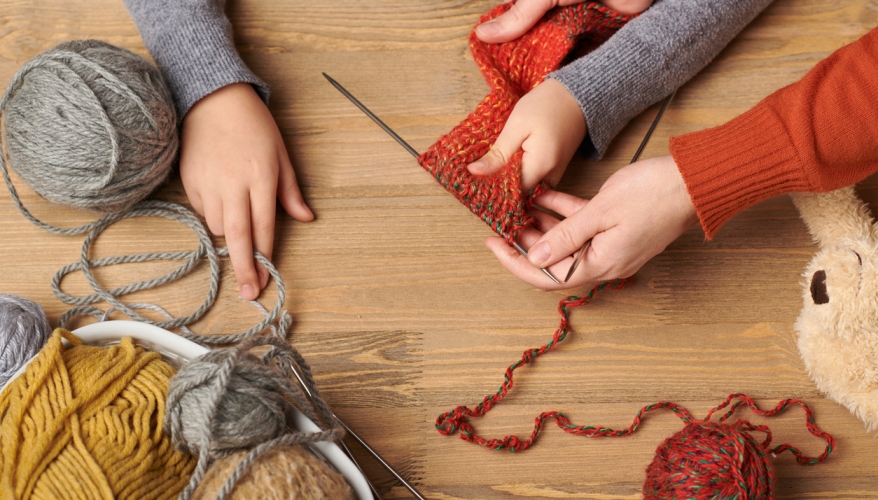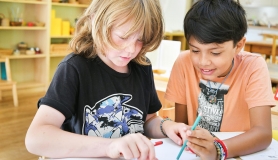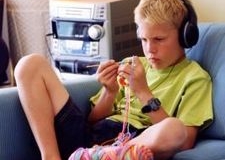Knitting fell into my lap quite by accident. I’d never been interested in learning how to knit until I moved to a small town and spent long, lonely days caring for my eight-month-old son at home. One day, I was invited to a ladies’ knitting group, and I was so starved for female companionship that I went, never having knitted a single stitch in my life.
The knitting ladies were not the white-haired crowd I expected. Instead, they were young women and new mothers, like myself, and they welcomed me warmly. They loaned me needles and yarn, and showed me how to cast on. As I fumbled my way through those first uneven rows, they settled back in their chairs for two hours of glorious conversation about life, love, children, and work. I wasn’t able to talk and knit at the same time, but I listened with a happy sense of relief, knowing that life wouldn’t be so hard in this new town, now that I’d discovered knitting.
Five years later, I’m still hooked on knitting, though its meaning has changed for me. The humble act of knitting embodies a philosophy about life that I want to pass on to my kids. It focuses on the importance of quality over quantity, shows respect for the environment, connects to the past, creates a product of beauty, and represents a practical, hands-on approach to life that I value greatly. Knitting also has surprising psychological benefits that make me a better, more relaxed parent. This is why I love it so much >
- Knitting is an oasis of calm amid the chaos of raising kids - The repetitive motion of knitting is relaxing, which reduces stress and anxiety. Dr. Herbert Benson, founder of Harvard’s Mind & Body Medical Institute, has studied something called the “relaxation response” in humans. By engaging in the repetition of a word, sound, phrase, prayer, or muscular activity such as knitting, people’s bodies will respond by decreasing heart rate, muscle tension, and blood pressure. So when you feel frustration mounting, just sit down with your knitting for a few minutes and let the tension melt away.
- Knitting will make you a happier parent - If you’re going through a rough patch, Knitting is growing in popularity as a form of therapy because it builds confidence and self-esteem, and motivates people who feel depressed to interact with the world. It’s a powerful distractant, helping many people cope with chronic pain. Even medical professionals are catching on, as the UK-based group Stitchlinks demonstrates. It is working to build an international network of knitting therapy groups throughout hospitals, long-term care facilities, doctors’ offices, and schools. Their website says, “Therapeutic knitting [is] being formally acknowledged by leading clinicians and academics for [its] benefits in mainstream healthcare.”
- Knitting offers an opportunity to connect with a child - It’s a handicraft that most school-aged children can handle with minimal guidance, once they learn the basic stitch. You will be able to sit and knit together, creating space for comfortable conversation that doesn’t require eye contact. Knitting can even help to calm excessively hyperactive children. A teacher in Toronto started a knitting club for seven- and eight-year-old boys, who loved it so much that they stayed in during breaktimes to knit. Knitting gave them a tremendous sense of accomplishment and helped them to focus.
- Knitting shows children that it’s worth taking time to create a product of high quality - So many of the clothes we wear nowadays lack true quality. They are imported from overseas factories, made to satisfy a season’s fleeting trends, and ultimately end up in landfill once their cheap fabric stretches after too many washes. A hand-knitted item, by contrast, has an intrinsic value that no store-bought “fast fashion” item can match. The investment of time, effort, and money that goes into each item guarantees that you will care for it years after a store-bought equivalent has disintegrated.
- Use knitting as a way to teach children about local industries - Similar to the farm-to-table movement that encourages people to know the source of their food, you might discover local yarn producers in your area. I recently visited an alpaca farm only minutes away from my home, and bought a skein of silky soft, hand-dyed yarn to knit a baby gift. There are few things as satisfying as working with yarn that comes from animals I’ve personally petted – and my kids were certainly impressed.
- Knitting is a basic lesson in activism for kids, since it reclaims control over clothing production - Most of us don’t make our own clothes anymore; sadly, those skills have been lost in just a few generations. But knitting is an easy way to show children how satisfying it is to wear something we’ve made ourselves. In a world where most tasks are performed by groups of highly specialized individuals and companies, insisting on making one’s own scarves, hats, mittens, and socks is a subtle act of rebellion against the system.
- Knitting is a temporary detox from our technology-saturated homes - Many children are surrounded by electronics, and it’s crucially important for them to learn how to entertain themselves without always relying on technology. Introduce them to knitting, and see how they delight in their own productivity, and discover the satisfaction that comes from working with one’s hands. At the least, children will learn to respect the amount of work that goes into making items that they may have previously taken for granted.
- Knitting enables parents and children to express themselves artistically - From choosing colour combinations and different textures of natural yarns to selecting a pattern that reflects one’s personal style, knitting is an opportunity for artistic self-expression. Patterns range from easy to complex, so there is always room for growth, and the most advanced knitters can learn how to design their own patterns.
So pick up some knitting needles, sit down with your child, and get started on a project today. If you’ve never done it before, most experienced knitters are more than happy to teach beginners, or else visit a local yarn store for classes.
Katherine lives on the shore of Lake Huron in Ontario, Canada. She writes about sustainable living for TreeHugger. When she’s not writing, she spends her days raising two little boys, sourcing and cooking local food, reading great books, and spending time outdoors.







